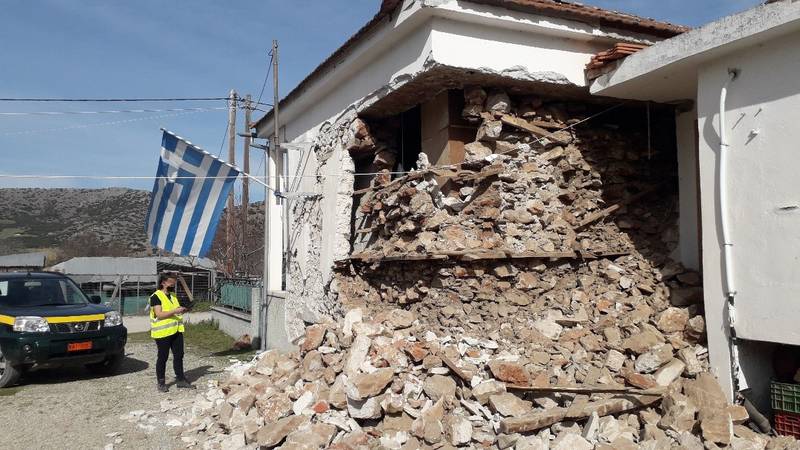CNN Article for the Work of HSGME – Statement by General Director Andreas Tsokos
The celebration of one hundred years since the founding of Greece’s Geological Service, marked on July 14, 2021, with the presentation of the commemorative album by the Hellenic Survey of Geology and Mineral Exploration (HSGME), also highlighted an important aspect of Greece’s economy and history—the exploitation of the nation’s geological wealth, which dates back to ancient times.
The fascinating world of rocks is one of the key areas of HSGME’s work. Research on volcanoes and seismogenic zones, landslide management, groundwater studies, hydrogeological drilling, geological mapping, and the creation of the country’s first National Geological Museum are among the many fields in which the HSGME is active.
Greece was one of the first European countries to establish a Geological Service (1919), initially under the Ministry of Transport. A few decades earlier, in 1861, the first “Mining Law” had been passed, later replaced by a new one in 1910. At that time, only a few Greeks were trained geoscientists, having studied or completed their education at European universities. In 1896, the Laboratory and Museum of Mineralogy and Petrology was founded at the University of Athens.
Since then, geological research in Greece has experienced both periods of decline and resurgence. The National Geological Service itself has changed names several times (such as IGEY, ETHIGME, IGME), with the latest key milestone in 2019. Under Law 4602/2019, IGME was dissolved and placed under liquidation, while its successor, the Hellenic Survey of Geology and Mineral Exploration (HSGME), was established as a public legal entity. The same law also set the framework for the exploration, exploitation, and management of the nation’s geothermal resources, designating HSGME as the official advisor of the Greek State on geothermal matters.
All this activity—focused on the study and management of Greece’s subsurface—is presented in a 416-page album that captures the past and present of Earth Sciences in Greece, enriched with rare photographic documentation. The album is available from the Authority for research purposes.
The current administration of the HSGME has launched an initiative to promote the country’s geological wealth as a cornerstone of its “heavy industry,” aiming to boost national growth and competitiveness. At the same time, it is developing collaborations with geological institutes around the world.

“We live in an era of transition. Climate change, the pandemic, and the need for a fairer distribution of resources are setting new priorities for governments and economies—priorities that align closely with sustainable development. In facing this challenge, the Hellenic Survey of Geology and Mineral Exploration plays a crucial role, contributing to a broad social transformation founded on advanced scientific understanding. The effective management of strategic natural resources, the energy transition from lignite to renewable sources, public health, smart cities, and digitalization represent the major challenges of our time—challenges the European Commission seeks to address through its planning,” notes Andreas Tsokos, General Director of HSGME, in his statement to CNN Greece.
At the core of HSGME’s operations remain the services it provides to local authorities. It has signed a memorandum of cooperation with the Civil Protection Agency, enabling its scientific teams to respond to landslides and offer consulting services to Regions and Municipalities. HSGME is also deeply involved in earthquake research. Recently, a team visited Elassona to conduct investigations in the seismogenic area and along active faults. Just weeks ago, HSGME undertook the establishment and operation of the National Database of Active Seismic Faults. This database will become a vital research and public information tool for assessing seismic risk. The decision was made by the Permanent Seismotectonic Committee of the OASP and complements two other ongoing projects: one on the impact of active fault structures in industrial areas, and another on the Revision of Greece’s Seismotectonic Map and its Integration with New Technologies and Geodatabases.

Geological mapping remains one of the key projects implemented by the HSGME, as does the systematic inventory of hydrogeological drillings, updating the national groundwater map.
The First National Geological Museum Becomes a Reality
At HSGME’s impressive facilities in Acharnes, renovation works are currently underway for the Mineral and Rock Museum, which will soon become Greece’s first National Geological Museum. Its exhibition halls will host more than 1,000 samples from the Authority’s historical collections, enriched by donations from private individuals and HSGME geologists. About 90% of the specimens originate from within Greece, while the rest come from abroad—including Brazil, India, China, Russia, Tibet, Romania, and Bulgaria. The newer collections feature samples mainly from Lavrion, Halkidiki, and the Cyclades. Carefully displayed in specialized showcases, these samples were collected over the course of a century of state geological research by geologists and mining engineers of the HSGME.
Educational Destination
The Hellenic Survey of Geology and Mineral Exploration is taking steps to secure, for the 2021–2022 school year, approval from the Ministry of Education and Religious Affairs to continue its educational program “The Wonderful World of Minerals and Rocks.” The program is designed for teachers and students in both primary and secondary education.
Students will have the opportunity to visit the Museum and observe minerals and rocks through an electron microscope (SEM), visit the Bottled Water Quality Control Laboratory, tour the “LITHOS” laboratory, and attend educational sessions in the amphitheater.
Source: CNN Gr


